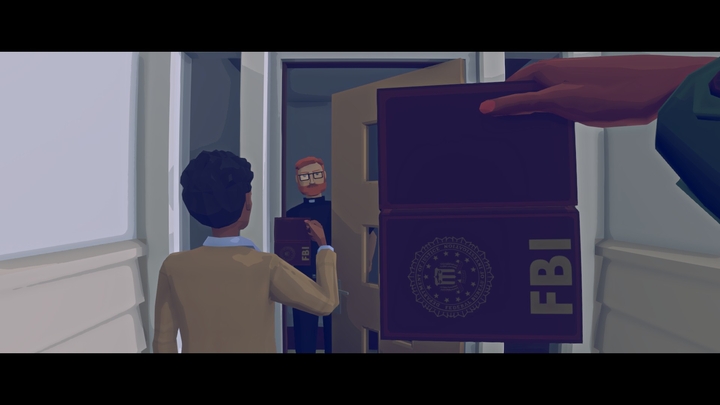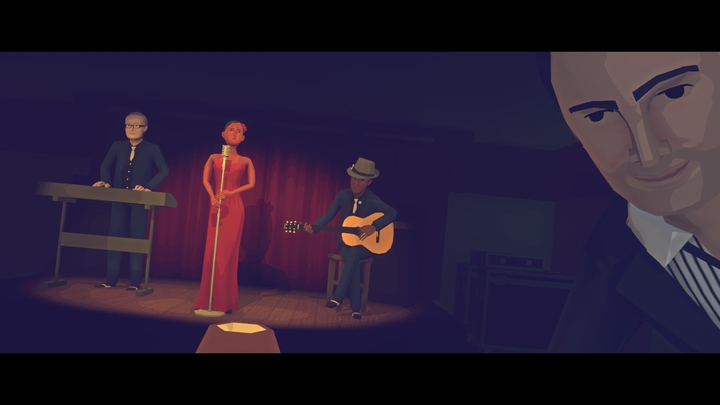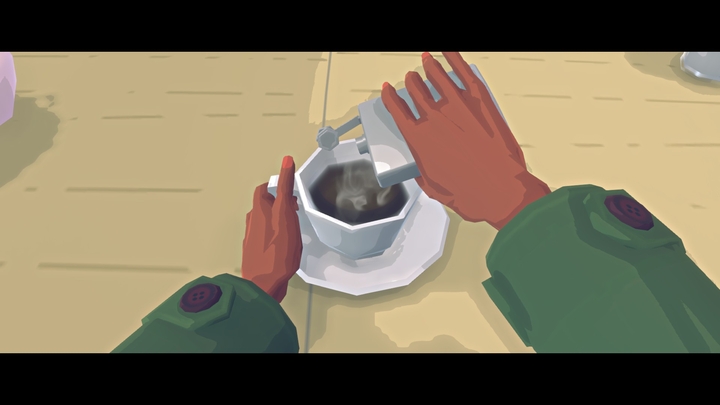Virginia review – Twin Peaks meets The X-Files
Made with a cinematic flair, Virginia tells a subtly emotional story with image alone. This game is trying to push the envelope when it comes to the limits of walking simulators while creating an eerie atmosphere reminiscent of Twin Peaks or The X-Files.
The review is based on the PS4 version. It's also relevant to PC, XONE version(s).

- Amazing atmosphere reminiscent of TV shows from the 90s revolving around conspiracy theories;
- Great storytelling – despite the lack of dialogue, the plot is skillfully unraveled;
- Cinematic cuts minimize any interaction, which is a good solution in this case;
- Music by Lyndon Holland performed by the Prague Symphony Orchestra;
- The ending!
- The widescreen black bars are always there, limiting the field of view;
- Some stuttering of the animation.
The expression “walking simulator”, defining a genre of video games in which the main, or in fact the only, task of the player is to traverse empty locations, is in my book somewhat pejorative, however accurate. With a couple of exceptions such as The Vanishing of Ethan Carter (which wasn’t entirely devoid of challenging mechanics), or Layers of Fear, which utilized pretty trite ways of scaring the player, thrilling and engaging post-adventure video games are few and far between.
There’s still room for experiments in the genre, which is best asserted by Virginia, developed by the Brits from Variable State. With a cinematic flair, the story inspired by popular TV shows from the 90s catches our eye with its extraordinary art style, dialogue-less narrative and abrupt cuts as if taken straight from a movie by David Lynch.
Twin Peaks meets X-Files
The player takes on the role of a rookie FBI agent. Her first assignment after being promoted is investigating a mysterious vanishing of a teenager from Kingdom, Virginia. The young officer’s partner is an experienced female agent by the name of Halperin, whose unconventional methods earned her notoriety in the bureau. Hence the second task of the protagonist is to monitor her new colleague as part of an internal investigation.
Since the game is set in the 90s, the developers drew inspiration from the television shows of that time. If you’re fans of such series as The Outer Limits, X-Files, or Twin Peaks, looking for references to these productions will become one of your main activities – that’s actually a metagame deliberately served by the team at Variable State studio.

Agent Halperin, whose office is located somewhere in the bureau’s basement, is basically Fox Moulder’s alter ego – an ambiguous character, remaining very enigmatic throughout most of the story. The protagonist, on the other hand, is a lot like Scully, trying to befriend her partner, but at the same time regularly sending reports about her to their supervisors.
I can assure you that such references, mostly inspired by Twin Peaks – including the red color appearing on a couple of occasions – can be found many times. The game tries to mess with the player by taking them on oniric, out-of-body trips that shed new light on some aspects of the investigation, and also provide a diversion from the mundane duties of an FBI agent.

Coffee and cigarettes
The atmosphere created by the developers and the emotions that accompany the subsequent days of the investigation are nearly palpable. The 90. in the American countryside in Virginia are shown through characteristic diners with a mandatory waitress serving coffee refills; there’s acrid cigarette smoke, archives full of microfilms, computers connected to the FBI’s database and not even the smallest trace of the Internet. To top it all off, everything is shrouded in an ambivalent symbolic layer, which is one of the plot’s foundations.
The game’s greatest asset and its driving force is the narration and the way the scenes are cut. Although it is a walking simulator, the developers wanted to limit the interaction as much as possible. It’s not like Dear Esther, where there was no interaction whatsoever, and the narrator was appearing when the player reached a predetermined place, but Virginia totally abandons the concept of unity of place and action. Locations are loaded in the background and sometimes they switch unexpectedly one from another. At one moment you’re riding shotgun in a car only to be transferred in an instance to a gas station. This kind of editing creates a truly cinematic vibe of the game. There’s no need to travel through miles of corridors. Even if such a sequence appears in the game, it serves to show something specific or to build the tension.
Thanks to the whimsical editing and the fact that the visited locations are not very big, the game never gets boring, and the two hours tops needed to finish it are over in a heartbeat. You can be sure that the first thing that will cross your mind once you witness the brilliant (!) ending will be to start the game over in order to find clues that might have been overlooked without knowing the entire story.

The finishing touch is the fantastic soundtrack written by Lyndon Holland and performed by the Prague Symphony Orchestra. Although Mr Holland’s previous experience only contains music for short films and documentaries, I really hope that this wasn’t his last affair with video game soundtracks. Virginia’s ending is a real eruption of sounds and emotions. I haven’t seen anything quite to engaging since the ending of Inside, but here the mood is truly epic thanks to the music.
What makes a game a movie
The story told in Virginia is at first simply intriguing, putting emphasis on different notes than most walking sims. The developers utilized cinematic means of expression, some of which may not be to your liking – the use of black horizontal bars at the top and bottom of the screen, for example, makes the game look panoramic. The thing is that the aspect seems to be the cinematic 2:35, which I find a bit weird – it works bad for the authenticity by looking too modern. On the other hand, I can’t imagine going as far as 4:3, since that would probably smother the whole atmosphere.
Another issue is the framerate, limited to 30 fps. While you can actually unlock it in the menu, the developers don’t recommend that. Virginia had constant issues with animation fluency on my PC (i5, GTX 970), which shouldn’t happen with this kind of graphics.

Go West, walk-sims
Virginia is an incredibly emotional and engaging story basically stripped of all video game features. The player’s only goal is to keep the narrative moving, without the need to scrutinize every location. Everything is right there in front of you – the cursor changes shape even if you’re pretty far from the interactive object.
The ingenious narration reinforced with cinematic editing makes you excited about discovering both what’s behind the corner, and how it will be presented. The framework the developers used were the classic TV shows: Twin Peaks and The X-Files. Borrowings, quotes, references – the intertextuality is everywhere, helping to make sense of the story, which, at the beginning, seems incoherent. If anyone ever tells you that walking simulators are boring, bring up Virginia. And walk away.
Virginia
Virginia review – Twin Peaks meets The X-Files
Made with a cinematic flair, Virginia tells a subtly emotional story with image alone. This game is trying to push the envelope when it comes to the limits of walking simulators while creating an eerie atmosphere reminiscent of Twin Peaks or The X-Files.

